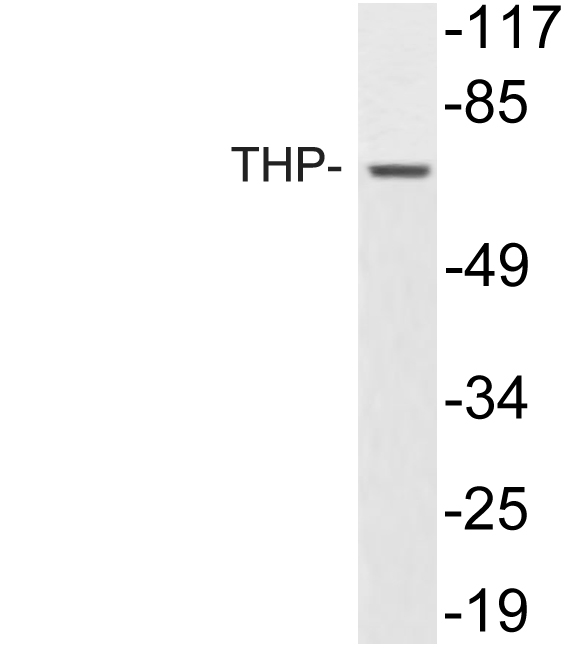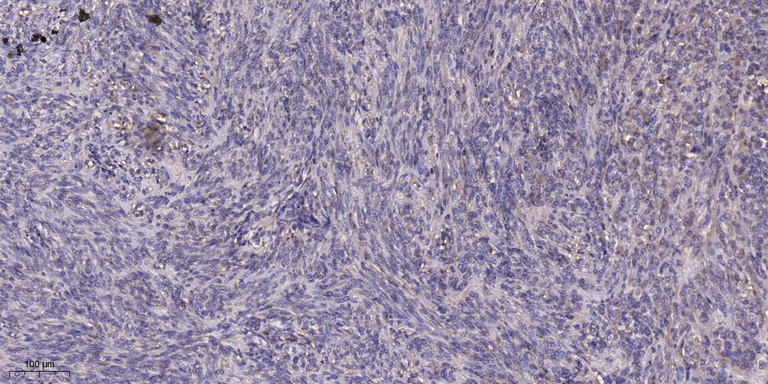- 首页
- 公司介绍
- 热门促销
-
全部产品
-
试剂盒
- |
-
一抗
- |
-
二抗
- |
-
蛋白
- |
-
免疫组化试剂
- |
-
WB 试剂
- PonceauS Staining Solution
- PBST Washing Buffer, 10X
- 1.5M Tris-HCl Buffer, pH8.8
- 1M Tris-HCl Buffer, pH6.8
- 10% SDS Solution
- Prestained Protein Marker
- TBST Washing Buffer, 10X
- SDS PAGE Loading Buffer, 5X
- Stripping Buffered Solution
- Tris Buffer, pH7.4, 10X
- Total Protein Extraction Kit
- Running Buffer, 10X
- Transfer Buffer, 10X
- 30% Acr-Bis(29:1) Solution
- Tris电泳液速溶颗粒
- PBS(1X, premixed powder)
- TBS(1X, premixed powder)
- 快速封闭液
- 转膜液速溶颗粒
- Chemical reagents
- 公司新闻
- 营销网络
- 资源中心
- 联系我们
THP Polyclonal Antibody
- 货号:YT4644
- 应用:WB;ELISA;IHC
- 种属:Human;Rat;Mouse;
- 免疫原:
- The antiserum was produced against synthesized peptide derived from human THP. AA range:329-378
- 特异性:
- THP Polyclonal Antibody detects endogenous levels of THP protein.
- 组成:
- Liquid in PBS containing 50% glycerol, 0.5% BSA and 0.02% sodium azide.
- 来源:
- Polyclonal, Rabbit,IgG
- 稀释:
- WB 1:500-2000;IHC 1:50-300; ELISA 2000-20000
- 纯化工艺:
- The antibody was affinity-purified from rabbit antiserum by affinity-chromatography using epitope-specific immunogen.
- 储存:
- -15°C to -25°C/1 year(Do not lower than -25°C)
- 其他名称:
- UMOD;Uromodulin;Tamm-Horsfall urinary glycoprotein;THP
- 背景:
- The protein encoded by this gene is the most abundant protein in mammalian urine under physiological conditions. Its excretion in urine follows proteolytic cleavage of the ectodomain of its glycosyl phosphatidylinosital-anchored counterpart that is situated on the luminal cell surface of the loop of Henle. This protein may act as a constitutive inhibitor of calcium crystallization in renal fluids. Excretion of this protein in urine may provide defense against urinary tract infections caused by uropathogenic bacteria. Defects in this gene are associated with the renal disorders medullary cystic kidney disease-2 (MCKD2), glomerulocystic kidney disease with hyperuricemia and isosthenuria (GCKDHI), and familial juvenile hyperuricemic nephropathy (FJHN). Alternative splicing of this gene results in multiple transcript variants. [provided by RefSeq, Jul 2013],
- 功能:
- disease:Defects in UMOD are a cause of glomerulocystic kidney disease with hyperuricemia and isosthenuria [MIM:609886]. Glomerulocystic kidney disease (GCKD) and medullary cystic disease/familial juvenile hyperuricemic nephropathy (MCKD/HNFJ) are two distinct renal disorders that share some common clinical features. The former is characterized by a cystic dilatation of Bowman's space and a collapse of glomerular tuft. Familial GCKD can be associated with either hypoplastic or normal sized kidneys. A GCKD clinical variant presents the association with hyperuricemia due to low fractional excretion of uric acid and severe impairment of urine concentrating ability that are reminiscent of MCKD/HNFJ.,disease:Defects in UMOD are the cause of familial juvenile hyperuricemic nephropathy (HNFJ) [MIM:162000]. HNFJ is a heritable autosomal dominant renal disease characterized by juvenil onset of hyp
- 细胞定位:
- Apical cell membrane ; Lipid-anchor, GPI-anchor . Basolateral cell membrane ; Lipid-anchor, GPI-anchor . Cell projection, cilium membrane . Only a small fraction sorts to the basolateral pole of tubular epithelial cells compared to apical localization (PubMed:22776760). Secreted into urine after cleavage (PubMed:18375198, PubMed:26811476). Colocalizes with NPHP1 and KIF3A (PubMed:20172860). .; [Uromodulin, secreted form]: Secreted . Detected in urine. .
- 组织表达:
- Expressed in the tubular cells of the kidney. Most abundant protein in normal urine (at protein level). Synthesized exclusively in the kidney. Expressed exclusively by epithelial cells of the thick ascending limb of Henle's loop (TALH) and of distal convoluted tubule lumen.

- Western blot analysis of lysate from K562 cells, using THP antibody.

- Immunohistochemical analysis of paraffin-embedded human Colon cancer. 1, Antibody was diluted at 1:200(4° overnight). 2, Tris-EDTA,pH9.0 was used for antigen retrieval. 3,Secondary antibody was diluted at 1:200(room temperature, 45min).





